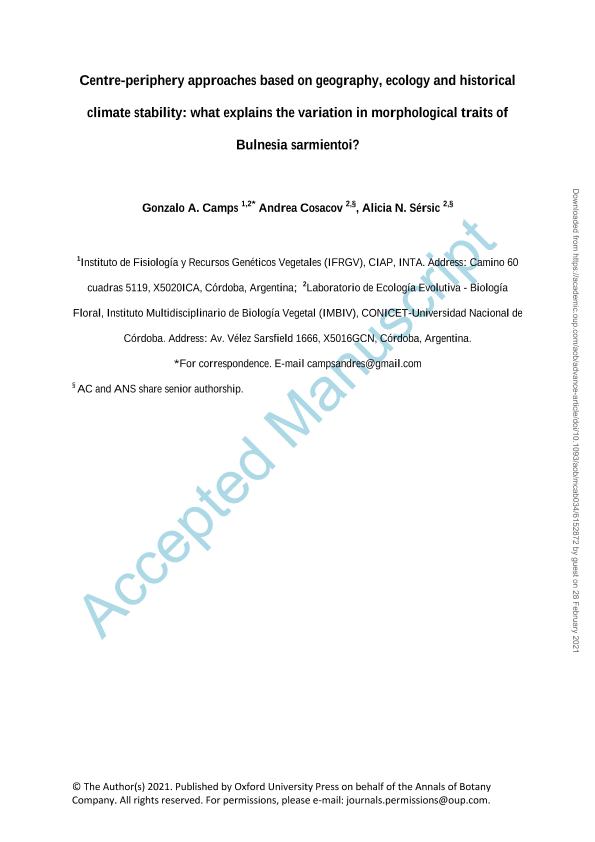Artículo
Centre–periphery approaches based on geography, ecology and historical climate stability: What explains the variation in morphological traits of Bulnesia sarmientoi ?
Fecha de publicación:
06/2021
Editorial:
Oxford University Press
Revista:
Annals of Botany
ISSN:
0305-7364
e-ISSN:
1095-8290
Idioma:
Inglés
Tipo de recurso:
Artículo publicado
Clasificación temática:
Resumen
The Centre-Periphery Hypothesis posits that higher species performance is expected in geographic and ecological centres rather than in peripheral populations. However, this is not the commonly found pattern; therefore, alternative approaches, including the historical dimension of species geographical ranges should be explored. Morphological functional traits are fundamental determinants of species performance, commonly related to environmental stability and productivity. We tested whether or not historical processes may have shaped variations in tree and leaf traits of the Chaco tree Bulnesia sarmientoi.MethodsMorphological variation patterns were analysed from three centre-periphery approaches: geographical, ecological and historical. Tree (stem and canopy) and leaf (leaf size and specific leaf area) traits were measured in 24 populations across the species range. A Principal Component Analysis was performed on morphological traits to obtain synthetic variables. Linear Mixed-Effects Models were used to test which of the implemented centre-periphery approaches significantly explained trait spatial patterns.Key ResultsThe patterns retrieved from the three centre-periphery approaches were not concordant. The historical approach revealed that trees were shorter in center populations than in the periphery. Significant differences in leaf traits were observed between the geographical centre and the periphery, mainly due to low specific leaf area values towards the geographical centre. We did not find any pattern associated with the ecological centre-periphery approach.ConclusionsThe decoupled response between leaf and tree traits suggests that these sets of traits respond differently to processes occurring at different times. The geographical and historical approaches showed centres with extreme environments in relation to their respective peripheries, but the historical centre has also been a climatically stable area since the Last Glacial Maximum. The historical approach allowed for the recovery of historical processes underlying tree traits variation, highlighting that centre-periphery delimitations should be based on a multi-approach framework.
Archivos asociados
Licencia
Identificadores
Colecciones
Articulos(IMBIV)
Articulos de INST.MULTIDISCIPL.DE BIOLOGIA VEGETAL (P)
Articulos de INST.MULTIDISCIPL.DE BIOLOGIA VEGETAL (P)
Citación
Camps, Gonzalo Andres; Cosacov Martinez, Andrea; Sersic, Alicia Noemi; Centre–periphery approaches based on geography, ecology and historical climate stability: What explains the variation in morphological traits of Bulnesia sarmientoi ?; Oxford University Press; Annals of Botany; 127; 7; 6-2021; 943-955
Compartir
Altmétricas




